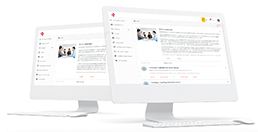Think of a virtual classroom as a traditional classroom, except you immerse yourself in the school through a computer or mobile device. Virtual classrooms share most features and benefits of the brick-and-mortar classroom.
However, the virtual classroom, by design, promotes student engagement and group collaboration. Use virtual classrooms as the primary source of instruction or use it as a supplement to the traditional classroom.
Don’t confuse online learning, distance learning, eLearning, mobile learning, and classroom learning with virtual classroom learning. The virtual classroom experience may use many educational tools, including eLearning or pre-recorded content.
Virtual classrooms aim to simulate the traditional classroom experience and use tools to make the experience more interactive. Teachers interact with their students. Students collaborate with their classmates.
One of the main benefits of virtual classrooms is the flexibility it offers. Instructors can pre-record sessions. The use of digital whiteboards simulates the traditional classroom. Students can ‘virtually’ raise their hand and still be able to contribute to group discussions.
Once an instructor becomes accustomed to the virtual classroom, they quickly see how much flexibility they have when teaching. Various studies show that virtual classroom instruction is becoming the most requested and delivered model, although other studies indicate the opposite, especially for young learners.
Managing Virtual Classrooms
The population of virtual classrooms is growing, especially since the pandemic. However, a thriving virtual classroom environment’s critical element is the learning experience’s instructional design and your virtual classroom software features.
If your learners primarily access virtual classes from home, they mainly need an internet connection, computer, or mobile device. Ensure your learning management platform integrates with popular virtual or webinar software such as Zoom or Microsoft Teams.
Instructional designers increasingly use blended learning accompanied by a workbook and PowePoint presentations. Virtual classrooms work well with a blended approach. Also, video, assessments, and social learning add interactivity to enhance the learning experience.

The inventor of the geodesic dome, J Buckminster Fuller, once said, “If you want to teach people a new way of thinking, don’t bother trying to teach them. Instead, give them a tool, the use of which will lead to new ways of thinking.” He would enjoy the virtual classroom if he were alive, as he had a love of learning.
Are the Lines Blurring Between the Traditional Classroom and Virtual Classroom?
The following are ‘pros’ of classroom learning from a training provider, Balance Global. Notice how the yes responses increasingly hold true for virtual classes and consider the additional features that cannot be replicated. The original article compared classroom versus eLearning.
| Traditional Classroom | Virtual Classroom | eLearning | |
| The Human Touch | Yes | Yes, if not recorded | No |
| Immediate Feedback | Yes | Yes, if not recorded | No |
| Interaction with other learners | Yes | Yes, if not recorded | No |
| Catering for different learning styles | Yes | Yes | No |
| More scope for varied exercises | Yes | Yes | No |
| Focus/removal of distractions | Yes | No | No |
| Team Building | Yes | Yes, with instructor help | No |
| Tailored Training | Yes | Yes | No |
What to Look for in a Virtual Classroom
There are various factors to consider to ensure virtual classrooms work. Some technologies and functionality are nice to have and increase learner user experiences, but a no-frills virtual classroom can still be effective. The instructional design, once again, is key to its success. The Instancy Learning Platform consists of five software modules, all built with the learner and instructor in mind. However, some of our critical components include:
1. Comprehensive communication system, including messaging, and voice chat
2. Video Streaming / Conferencing is as close to a live, in-person situation as possible
3. Ability to share files as instructors must have adequate resources to share work and students to submit their work
4. The ability of the student to ‘raise their hand’ during the live course or event
5. Digital Whiteboard – the whiteboard is an integral part of the learning experience, no matter how the course is delivered
6. Group discussion facilities and virtual meeting rooms – in some cases, it may even be a mini virtual classroom itself to facilitate meaningful group communication
7. Easy integration of third-party tools and plug-ins

Instancy Virtual Classroom Event Management System
Create and manage webinars and virtual classes from within Instancy Learning Management System (iLMS). Add powerful Zoom, GoToMeeting, or GoToTraining (by Citrix) web conferencing capability to events created within iLMS. Conduct live, interactive meetings and presentations and share your desktop with your students. Increase course completion rates by combining eLearning with virtual classrooms.
Your authors can schedule virtual classrooms from the same content-authoring system where they create eLearning courses and manage media, documents, and quizzes. Instructors can view student enrollment and mark attendance. Students can enroll, view, and track their progress.
Training Administrators can view student participation and progress reports for stand-alone and blended learning programs in a single place. Assign certificates or gamify (create game-like learning incentives) your virtual classroom programs with Instancy Learning Management System.
Create webinars and virtual classes from within Instancy LMS without having to sign into multiple applications. You can schedule your webinar, assign instructors, and create presenter and participant URLs. Registered users can launch the webinar directly from the Instancy LMS web interface.
Publish webinar events to the catalog for the users to search, view, and enroll. Use the eCommerce feature to sell your courses. Create webinar events with a waitlist option. Approve the waitlisted registrants automatically if any confirmed users cancel their enrollments.
Share your presentations, desktop screen, and videos online with the attendees. Share keyboard and mouse interactions and enable attendees to make changes to shared documents. Increase participation by using built-in drawing and screen highlighting tools.
Record a webinar with all the screen-share activities you used during the event. The recorded webinar can be auto-published into the LMS catalog after initial viewing by people who could not attend the live event. You can even monetize the recorded session.
Conclusion
Think of a world where we learn through our everyday lives. When we travel, we can study as we go. Study science at famous science museums. Find our comfortable space at home, where we focus on the topic we choose. At Instancy, we’re excited about that future. Won’t you join us?





